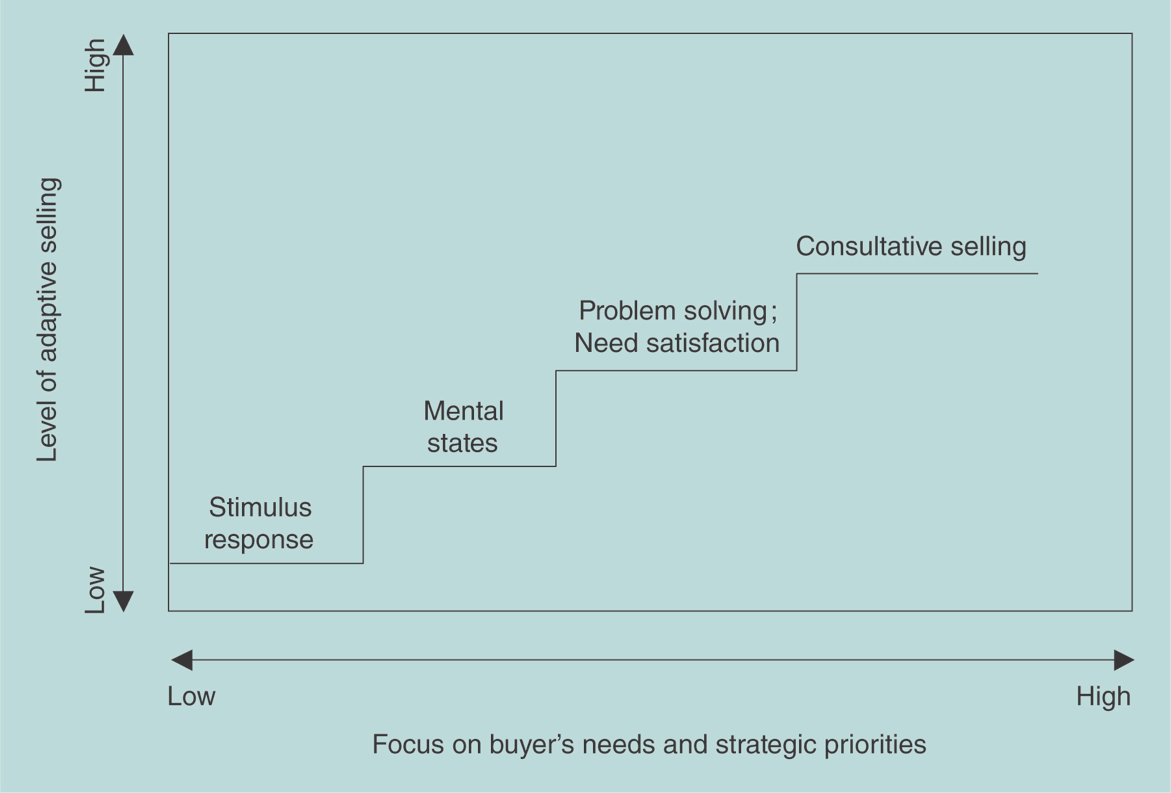Main Content
Lesson 2: Overview of Personal Selling
Five Approaches to Personal Selling and Skills
Ingram et al. (2015) indicate that personal selling is especially critical for companies that sell to other businesses, and they explain that this does not mean that personal selling is unimportant to retailers and others who sell directly to ultimate consumers. Instead, they state,
Salespeople are used in a variety of sectors, including retailing, automotive, real estate, insurance and financial services, among others. They are particularly useful for selling high dollar items and relatively expensive unsought goods and services. In the case of a company such as Tupperware, they provide an alternative means for distributing product to consumers. (Chapter 2, p. 5)
Figure 2.1 shows five approaches to personal selling
As the text explains, as the level of need and strategic priorities increases, an inceasing level of adaptive selling is required. Customers should be prioritized in terms of salesforce focus and effort to cater to consultative selling of the prospects that are most promising in terms of customer lifetime value. However, although this is generally the case, this depends on the goals of the organization and corporate mission, as some organizations may be more focused on transactions and high volume, they may not want to invest resources in collaborative selling.
- stimulus response,
- mental states,
- problem solving,
- need satisfaction, and
- consultative selling.

Listening and Questioning Skills
Ingram et al. (2015) discuss that different approaches require different skills. In terms of listening and questioning skills, they point out that "listening and questioning skills are most often utilized in need satisfaction, problem-solving and consultative selling approaches" (Chapter 2, p. 6).
Below is their explanation how those two skills are needed in those approaches:
- Need satisfaction selling focuses on the customer. Salespeople use questions to uncover buyer needs, and the customer typically dominates the sales interaction until needs have been established. At that point, the salesperson moves to a more active selling role, describing how their offering can satisfy the buyer’s needs.
- Problem-solving selling extends need satisfaction selling beyond identifying needs to developing alternative solutions for satisfying these needs. This typically requires extensive questioning and listening very carefully to customer concerns.
- Consultative selling is the process of helping customers reach their strategic goals by using the products, services, and expertise of the sales organization. Consultative selling requires that the salesperson be an expert on the customer’s business, competitors, and market developments. (Ingram et al., 2015, Chapter 2, p. 6)
Ingram et al. (2015) emphasize that "to truly understand a customer’s business, the salesperson must be heavily involved in questioning and listening. Questioning and listening is also important as salespeople often must garner the support of others within their organization to help solve customer problems" (Chapter 5, p. 6).
Sales Dialogue
Ingram et al. (2015) also point out that the three approaches mentioned above (need satisfaction selling, problem-solving selling, and consultative selling) are most likely to involve sales dialogue. They provide the following explanation:
Sales dialogue involves business conversations that take place over time as salespeople attempt to initiate, develop, and enhance relationships with customers. It features a back-and-forth, two-way conversation between buyers and sellers, with both parties benefiting from their participation. Common sales dialogues include:
- determining if a prospective customer has the financial resources and an adequate interest in making a future purchase to warrant additional follow-up
- assessing the prospective customer’s situation and buying processes
- discovering the prospective customer’s specific needs and requirements
- confirming the prospective customer’s strategic priorities
- illustrating how the sales organization can create and deliver customer value
- negotiating an agreement to do business
- building customer value by providing additional opportunities
- assessing the extent to which the customer is satisfied with the value received. (Chapter 2, p. 6)
Reference
Ingram, T. N., LaForge, R. W., Avila, R. A., Schwepker, C. H., Jr., & Williams, M. R. (2015). Instructor manual for Sales management: Analysis and decision making (9th ed.). New York, NY: Routledge.
